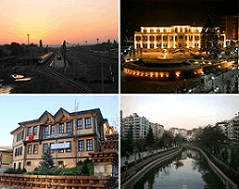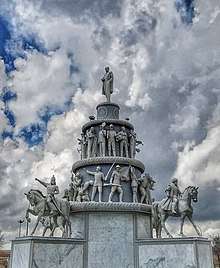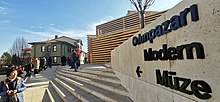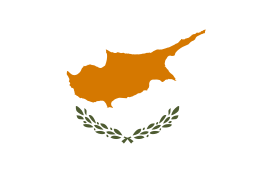Eskişehir
Eskişehir (US: /ˌɛskɪʃəˈhɪər/ ES-kish-ə-HEER,[2][3] Turkish: [esˈciʃehiɾ]; from eski "old" and şehir "city")[4] is a city in northwestern Turkey and the capital of the Eskişehir Province. In the Byzantine era its name was Dorylaeum.[5] The urban population of the city is 717,135 with a metropolitan population of 826,135.[1] The city is located on the banks of the Porsuk River, 792 m above sea level, where it overlooks the fertile Phrygian Valley. In the nearby hills one can find hot springs. The city is 233 km (145 mi) to the west of Ankara, 330 km (205 mi) to the southeast of Istanbul and 78 km (48 mi) to the northeast of Kütahya. Known as a university town, both Eskişehir Osmangazi University and Anadolu University (which has one of the largest student enrollments in the world) are based in Eskişehir. The province covers an area of 2,678 km2 (1,034 sq mi).[6]
Eskişehir | |
|---|---|
 Top left:Eskişehir Central railway station, Top right: Tepebaşı Municipality, Bottom left: Museum of Modern Glass Art, Bottom right: Porsuk River. | |
 Eskişehir Location of Eskişehir  Eskişehir Eskişehir (Europe) | |
| Coordinates: 39°47′N 30°31′E | |
| Country | Turkey |
| Region | Central Anatolia |
| Province | Eskişehir |
| Government | |
| • Metropolitan Mayor | Yılmaz Büyükerşen (CHP) |
| Area | |
| • Metropolitan municipality | 2,678.00 km2 (1,033.98 sq mi) |
| Elevation | 788 m (2,585 ft) |
| Population (2016)[1] | |
| • Metropolitan municipality | 844,842 |
| • Density | 236/km2 (610/sq mi) |
| • Metro | 734,807 |
| Time zone | UTC+2 (EET) |
| • Summer (DST) | UTC+3 (EEST) |
| Postal code | 26 xxx |
| Area code(s) | (+90) 222 |
| Registration plate | 26 |
| Website | http://www.eskisehir-bld.gov.tr/ |
History
.jpg)
The name Eskişehir literally means "Old City" in Turkish. The city was founded by the Phrygians in at least 1000 BC, although it has been estimated to be older than 4000 years old. The current city lies about a mile from the ancient Phrygian city of Dorylaeum.[7] Many Phrygian artifacts and sculptures can still be found in the city's archeological museum. There is also a museum of meerschaum stone, whose production remains still notable, used to make high quality meerschaum pipes. In the fourth century AD the city moved about ten km northeast, from Karacahisar to Şehirhöyük.
Many ancient geographers described the city as one of the most beautiful in Anatolia.
As with many towns in Anatolia, Christianity arrived after Constantine the Great legalized the religion in the Roman Empire. Beginning in the 4th century, records exist of bishops holding office in Eskişehir. The city was known as Dorylaeum (Δορύλαιον) in Greek in that period. One of these bishops, Eusebius, was heavily involved in shaping the evolving dogma of the church.
It was called Sultanönü during the Seljuk period.[8] In 1097 it was the site of a battle in which the First Crusade defeated Kilij Arslan I; the town later fell to the Turks in 1176.[7]
Economy
Traditionally dependent on flour milling and brickyards, the city expanded with the building of railway workshops in 1894 for work on the Berlin-Baghdad Railway.
As of 1920, Eskişehir was one of the major locations for meerschaum mining. At that time, most of the mining sites were owned by the state.[9]
Devrim, the first Turkish automobile, was produced in 1961 at the TÜLOMSAŞ factory in Eskişehir. Devrim never put into mass production and stayed a concept study and can be viewed in TÜLOMSAŞ factory Eskişehir. In addition to production, first Turkish steam powered locomotive called Karakurt was produced at the TÜLOMSAŞ in 1961. Eskişehir was also the site of Turkey's first aviation industry (Aeronautical Supply Maintenance Centre) and its air base was the command center of Turkey's first Tactical Air Force headquarters on NATO's southern flank during the Cold War.
Eskişehir produces trucks, home appliances, railway locomotives, fighter aircraft engines, agricultural equipment, textiles, brick, cement, chemicals, processed meerschaum and refined sugar. Eti, one of Turkey's largest food brands (mostly producing biscuit, chocolate and candy varieties) is based in Eskişehir. Arçelik, a major Turkish home appliances and consumer electronics manufacturer, has one of its production plants in Eskişehir. Eskişehir was the first stage of High-speed rail in Turkey from Ankara. This service improved the travel and commerce between Eskişehir and Ankara, thanks to reduced journey time. GKN, a major global automotive supplier for passenger and commercial car powertrain systems has a plant in Eskişehir.
The city is served by the Anadolu Airport.
Education
.jpg)
.jpg)

There are three universities in Eskişehir. These are the Anadolu University, Eskişehir Osmangazi University and the Eskişehir Technical University. In addition to its on-campus study offering, Anadolu university started open university courses through TV broadcast already in the 1980s, allowing access to thousands of students who otherwise would not have been able to benefit from tertiary education. The current Metropolitan Mayor of Eskişehir, Prof. Dr. Yılmaz Büyükerşen, was formerly the rector of the Anadolu University.
Culture
The city has a significant population of Turkic Crimean Tatars. It also attracted ethnic Turks emigrating from Balkan countries such as Bulgaria, Romania, Bosnia, Macedonia and the Sandžak region of Serbia, who contributed to the development of the city's metalworking industries. Eskişehir also hosted the inaugural Turkvision Song Contest in 2013, which aims to highlight music and artists from various Turkic-speaking regions. The city is also home to the Dünya Müzeleri Müzesi or Museum of World Museums.
Other museums in the city are Eti Archaeology Museum, Aviation Museum, Meerschaum Museum, Museum of Independence, Museum of Modern Glass Art, Tayfun Talipoğlu Typewriter Museum, Yılmaz Büyükerşen Wax Museum and the Odunpazarı Modern Museum.
Attractions
Most of modern-day Eskişehir was rebuilt after the Turkish War of Independence (1919–1923), but a number of historic buildings remain, such as the Kurşunlu Mosque. The archaeological site of the ancient Phrygian city of Dorylaeum is close to Eskişehir. The city is noted for its natural hot sulphur springs.
Climate
Eskişehir has a cold semi-arid climate (BSk) under the Köppen climate classification, with the city near the borderline of a dry-summer humid continental climate of both the warm-summer (Dsb) and hot-summer (Dsa) subtypes, and a mediterranean climate of both the warm-summer (Csb) and hot-summer (Csa) subtypes.[10][11] The city features cold, snowy winters and warm, dry summers. Rainfall occurs mostly during the spring and autumn. Due to Eskişehir's high altitude and its dry summers, nightly temperatures in the summer months are cool. Precipitation levels are low, but precipitation can be observed throughout the year.
| Climate data for Eskişehir (1960–2012) | |||||||||||||
|---|---|---|---|---|---|---|---|---|---|---|---|---|---|
| Month | Jan | Feb | Mar | Apr | May | Jun | Jul | Aug | Sep | Oct | Nov | Dec | Year |
| Record high °C (°F) | 20.2 (68.4) |
22.3 (72.1) |
29.1 (84.4) |
31.2 (88.2) |
33.9 (93.0) |
36.8 (98.2) |
40.6 (105.1) |
39.0 (102.2) |
36.4 (97.5) |
33.0 (91.4) |
25.4 (77.7) |
21.4 (70.5) |
40.6 (105.1) |
| Average high °C (°F) | 4.0 (39.2) |
6.4 (43.5) |
11.4 (52.5) |
17.0 (62.6) |
21.9 (71.4) |
25.9 (78.6) |
29.1 (84.4) |
29.3 (84.7) |
25.4 (77.7) |
19.4 (66.9) |
12.5 (54.5) |
6.1 (43.0) |
17.4 (63.3) |
| Daily mean °C (°F) | 0.0 (32.0) |
1.5 (34.7) |
5.2 (41.4) |
10.3 (50.5) |
15.1 (59.2) |
19.1 (66.4) |
21.8 (71.2) |
21.6 (70.9) |
17.3 (63.1) |
11.9 (53.4) |
6.3 (43.3) |
2.1 (35.8) |
11.0 (51.8) |
| Average low °C (°F) | −3.5 (25.7) |
−2.8 (27.0) |
−0.3 (31.5) |
3.8 (38.8) |
7.9 (46.2) |
11.4 (52.5) |
14.0 (57.2) |
13.7 (56.7) |
9.6 (49.3) |
5.4 (41.7) |
1.1 (34.0) |
−1.3 (29.7) |
4.9 (40.9) |
| Record low °C (°F) | −27.8 (−18.0) |
−23.8 (−10.8) |
−16.5 (2.3) |
−10.4 (13.3) |
−2.2 (28.0) |
0.5 (32.9) |
5.0 (41.0) |
3.6 (38.5) |
−2.0 (28.4) |
−7.1 (19.2) |
−14.7 (5.5) |
−20.3 (−4.5) |
−27.8 (−18.0) |
| Average precipitation mm (inches) | 40.6 (1.60) |
32.6 (1.28) |
37.8 (1.49) |
40.6 (1.60) |
43.0 (1.69) |
32.8 (1.29) |
13.0 (0.51) |
9.2 (0.36) |
15.1 (0.59) |
29.8 (1.17) |
30.0 (1.18) |
45.5 (1.79) |
370 (14.55) |
| Average rainy days | 13.8 | 11.7 | 12.0 | 11.0 | 10.7 | 7.4 | 3.5 | 2.8 | 4.1 | 7.7 | 9.5 | 13.2 | 107.4 |
| Average snowy days | 10 | 9 | 5 | 1 | 0 | 0 | 0 | 0 | 0 | 0 | 3 | 6 | 34 |
| Mean monthly sunshine hours | 77.5 | 140.6 | 158.1 | 183 | 260.4 | 309 | 353.4 | 331.7 | 267 | 186 | 123 | 65.1 | 2,454.8 |
| Source 1: Devlet Meteoroloji İşleri Genel Müdürlüğü [12] | |||||||||||||
| Source 2: Weather2 [13] | |||||||||||||
Sports

Association football club Eskişehirspor, founded in 1965, plays in the TFF First League. It plays its home games in the Eskişehir Atatürk Stadium.
Notable natives
- Eusebius of Dorylaeum – 5th century bishop
- Battal Gazi – 8th century Muslim saint buried in Seyitgazi
- Yunus Emre – 13th century Turkish folk poet
- Sheik Edebali – 13th century religious leader, spiritual founder of the Ottoman Empire
- Behiç Erkin - Turkish Schindler, first director (1920–1926) of the Turkish State Railways, Minister of Public Works (1926–1928), Turkish Ambassador (Budapest 1928–1939, Paris and Vichy 1939-1943)
- Yakup Satar - last Turkish veteran of the First World War
- Fahrettin Kerim Gökay - Professor, former Mayor of Istanbul (1949–1957), former Turkish Ambassador (Bern), former Minister of State
- Yılmaz Büyükerşen - Professor, Metropolitan Mayor of Eskişehir, Reporter, Columnist, Caricaturist, Editor, former Rector of Anadolu University, former member of RTYK, Professional Wax Sculptor
- Cüneyt Arkın - Actor, Director, Producer, Martial Artist, Doctor in Medicine
- Nuri Alço - Actor, Director, Producer
- Eqrem Çabej - Linguist and scholar
- Melis Birkan - Actress
- Zeki Sezer - former Leader of the Democratic Left Party DSP, Chemical Engineer, Minister of State (57th government)
- Hasan Polatkan - Politician
- Mehmet Terzi - Long-Distance Runner
- Gamze Bulut - Mid-Distance Runner
- Zeki Önder Özen - Football Manager
- Ömer Çatkıç - Football Goalkeeper
- Neslihan Demir Darnel - Volleyball Player
- İpek Şenoğlu - Tennis Player
- Ersan İlyasova - Basketball Player
- Kerem Gönlüm - Basketball Player
- Ceyhun Yıldızoğlu - Basketball Coach
- Asya (singer) - Pop Singer, Song-Writer
- Tuna Kiremitçi - Author, Poet, Columnist, Composer
- Enis Batur - Author, Lecturer
- Alper Erturk - Professor at Georgia Institute of Technology
- Gürer Aykal - Conductor, Adjunct Professor at Bilkent University
- Banu Avar - Writer and journalist
- Hasan Piker - Political commentator
- Mete Erpek (Joker) - Rapper
Non-natives
Fikri Cantürk, Professor of Painting, Anadolu University
International relations
Twin towns — sister cities
Eskişehir is twinned with:[14]






.svg.png)
See also
- Anadolu University
- Boron
- Eskişehir Osmangazi University
- Meerschaum
- Türkvizyon Song Contest 2013
- Holy Trinity Church, Eskişehir
Notes
- "Turkey: Major cities and provinces". citypopulation.de. Retrieved 2015-02-08.
- "Eskisehir". Oxford Dictionaries US Dictionary. Oxford University Press. Retrieved May 30, 2019.
- "Eskisehir". Merriam-Webster Dictionary. Retrieved May 30, 2019.
- Lewis Thomas (Apr 1, 1986). Elementary Turkish. Courier Dover Publications. p. 12. ISBN 978-0486250649.
- E.J. Brill's First Encyclopaedia of Islam 1913-1936. BRILL. 1987. ISBN 978-90-04-08265-6.
- Statoids. "Statistical information on districts and town centers in Turkey". Retrieved 2008-04-12.
- Chisholm 1911.
- Türkiye İller Ansiklopedisi 1.Cilt s.409
- Prothero, G.W. (1920). Anatolia. London: H.M. Stationery Office. p. 105.
- Öztürk, Mehmet Zeynel; Çetinkaya, Gülden; Aydın, Selman. "Köppen-Geiger İklim Sınıflandırmasına Göre Türkiye'nin İklim Tipleri/Climate Types of Turkey According to Köppen-Geiger Climate Classification". Coğrafya Dergisi – Journal of Geography. 35 (2017): 17–27. doi:10.26650/JGEOG295515. Retrieved 23 June 2020. (in Turkish and English)
- Updated world map of the Köppen-Geiger climate classification - Hydrology and Earth System Sciences Discussions
- "İl ve İlçelerimize Ait İstatistiki Veriler- Meteoroloji Genel Müdürlüğü". Dmi.gov.tr. 2006-09-21. Retrieved 2013-03-24.
- "July Climate History for Eskisehir | Local | Turkey". Myweather2.com. Archived from the original on 2013-08-01. Retrieved 2013-03-24.
- "Kardeş Şehirler". eskisehir.bel.tr (in Turkish). Eskişehir. Retrieved 2020-01-18.
References
- Falling Rain Genomics, Inc. "Geographical information on Eskişehir, Turkey". Retrieved 2008-04-03.
- Municipality of Eskişehir, Turkey. "General information on Eskişehir". Archived from the original on May 17, 2008. Retrieved 2008-04-03.
External links
| Wikimedia Commons has media related to Eskişehir. |
| Wikivoyage has a travel guide for Eskişehir. |
- District governor's official website (in Turkish)
- District municipality's official website (in Turkish)
- Eskişehir Police Headquarters (in Turkish)
- Eskişehir News (in Turkish)
- Eskişehirspor Sports Club
- . Encyclopædia Britannica. 9 (11th ed.). 1911. p. 771.
